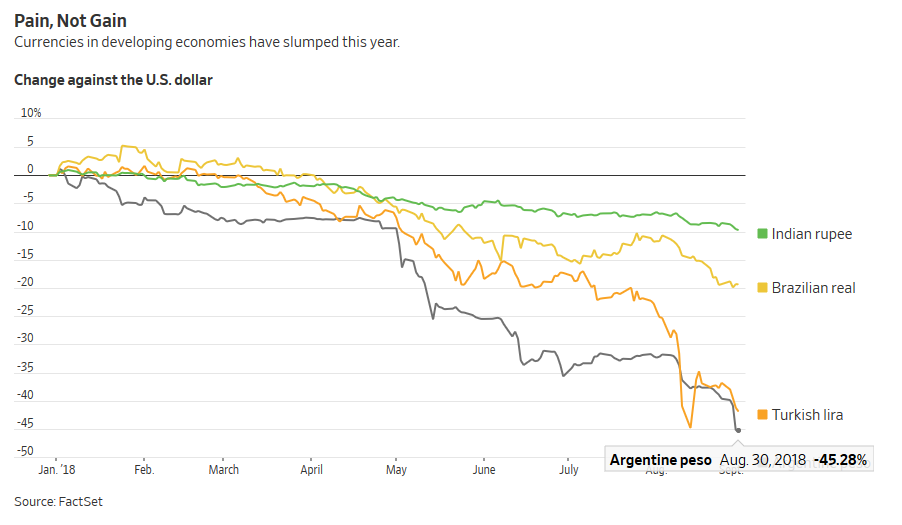The emerging markets crisis is real, more on rising xenophobia, the CRE bubble and California as regulatory standard setter
The emerging markets crisis is real now
More and more people are talking about the spillover of Fed policy into emerging markets as the crisis there gathers pace. I know the Fed Chairman Powell has said that EM is not his concern. Nevertheless, we are reaching a point where he may start to backtrack on those statements.
Here’s the Wall Street Journal just yesterday:
The tumult highlights a heavy international dependence on the dollar. Some 48% of the world’s $30 trillion in cross-border loans are priced in the U.S. currency, up from 40% a decade ago. Exchange-rate fluctuations affect the ease of servicing that debt. And with U.S. interest rates still low by historical standards and the dollar only halfway back to its 2016 highs, the stress could increase as the Fed keeps tightening.
“After what we saw happen in Turkey, the market started to ask what country was next: South Africa, Brazil, Indonesia,” said Eric Wong, a fixed-income portfolio manager at Fidelity International. “The market is still gripped at times by fear, trying to differentiate the good ones from the bad ones.”
The market moves come amid a debate about the effects of U.S. monetary policy on the rest of the world—and how they might cycle back to the U.S.
“Given the dominance of U.S. financial markets and institutions, and the dollar’s prominence in global finance, any actions taken by the Fed inevitably reverberate around the world,” said Eswar Prasad, professor of economics at Cornell University.
Fed Chairman Jerome Powell said in May that “the role of U.S. monetary policy is often exaggerated” when it comes to global financial conditions, with fast growth in emerging economies, and commodity prices, playing bigger roles in capital flows. His counterparts in India and Indonesia, however, have voiced concerns about the Fed’s policy direction and pleaded for more international coordination.
This accompanying chart is brutal.

Why this matters: we are definitely in crisis mode now in the emerging markets. The Fed has to realize that its policies are having a dramatic impact there. What that would mean in terms of policy is unclear. But right now the scramble for US dollars is on. I would say that the panic that foreign debtors feel actually causes the dollar to be even stronger against EM currencies than it otherwise would be.
Eventually, we are going to see defaults.
P.S. – Notice how the 100-year Argentina bond strengthened under Yellen but has dramatically weakened under Powell.

To me, that speaks to a Fed regime shift.
More on the normalization of xenophobia in Europe (and the US)
On a different note, I want to talk about human psychology here because I believe people are very malleable. You’ve heard the term ‘mob psychology’. It’s usually used to describe a situation where otherwise rational people are worked into an irrational frenzy due to the peer pressure of a large crowd. Far from the ‘wisdom of crowds’, it shows the psychosis of mobs.
Well, I think this is just an extreme example of how social psychology works. You’ve heard the German term Zeitgeist? It’s a concept from 18th and 19th-century German philosophy, and literally means “spirit of the times”.
Well, the spirit of the times in the West is increasingly anti-immigrant.

That’s a photo by the Daily Beast from Chemnitz. I discussed what’s going on there the other day. The New York Times does a good job in depicting what’s happening. Let me excerpt some key paragraphs from them.
Waving German flags, with some flashing Nazi salutes, the angry mob made its way through the streets, chasing after dark-skinned bystanders as police officers, vastly outnumbered, were too afraid to intervene.
A Syrian refugee and father of two, Anas al-Nahlawie, watched horrified from a friend’s fourth-floor balcony. They were hunting in packs for immigrants just like him, he said. “Like wolves.”..
The city had never seen anything like this — and, to some degree, neither had post-World War II Germany. The rampage now stands as a high-water mark in the outpouring of anti-immigrant hatred that has swelled as Germany struggles to absorb the nearly one million asylum seekers who arrived in the country after Chancellor Angela Merkel decided to open the borders in 2015…
Neo-Nazis are growing bolder and stronger, and they are better organized, officials and sociologists say. The far-right Alternative for Germany party is a growing power in Parliament — another shock to the system — and has started to normalize angry sentiments about immigrants that before would not have been uttered aloud, bringing them into the mainstream.
In the face of this newly assertive far right, Chemnitz has become a test of state authority. Some say it has even become a test of Germany’s postwar democracy.
Why this matters: If you take away one thing here, it’s the word in the penultimate paragraph “normalize”. The Zeitgeist exists because certain things get normalized, accepted and gain currency. Some previously normal things become cool. And some previously shunned behaviors and norms become ‘normalized’.
Deeper dive: This isn’t happening just in Europe, of course. Look at this video in the US of a US-born Portland student being harassed by a woman after she hit his car. Hit up the twitter link to see the vid.
‘You were not born here.’ — This woman interrogated a U.S.-born student over his citizenship after she allegedly hit his car pic.twitter.com/7FRVkjErDA
— NowThis (@nowthisnews) August 30, 2018
Ask yourself whether she would be acting this way before Trump. He has normalized this kind of behavior, this blanket suspicion of ‘foreigners’. And, since the exact same thing is happening in Europe, it’s clear this isn’t about Trump. Sure he is fanning the flames. But he is emblematic of a backlash in the west against globalization, immigration, etc, etc. And even though Trump has become more unpopular after Manafort and Cohen, these issues will continue to have resonance in the US.
I think the conflict associated with this struggle will get worse, perhaps much worse.
(WeWork and) the Commercial real estate bubble
I plan on writing something about WeWork soon because I think they a company that is emblematic of the CRE bubble in the US. But the key to note is the risk that investors are taking on here – as it was a year ago with the 100-year US dollar denominated Argentina bond.
Here’s the FT:
Investors are stomaching the lowest premium in more than a decade for taking on more risk in the US commercial property market, as a humming American economy encourages money managers to reach for higher returns.
The difference between the return on the safest slices of commercial mortgage-backed securities — a pool of mortgages bundled into a bond — and the riskier slices has dropped to its lowest level since the build-up to the financial crisis, according to data from Trepp, a data analytics company.
This is what’s called reaching for yield. And this is happening even as the Fed is normalizing policy rates.
Why this matters:
“As you get toward the latter innings of the credit cycle, people have money they need to put to work and they take on more risk for less return,” said Alan Todd, a CMBS analyst at Bank of America Merrill Lynch.
Eventually you’re going to have an ‘accident’, mass defaults. And if you are looking for a sector that is likely to be caught up in the next financial crisis, CRE is definitely high on that list.
Where WeWork comes in – and I will explain this more fully later – is in creating artificial demand. They add a bid to commercial property that increases prices in a way that will create a panic when the demand from WeWork evaporates in the next downturn.
California and Net Neutrality
Remember my comments a couple of weeks back about the EU taking a global regulatory lead due to the size of the EU market? Well, I think of California in similar terms in the US. This is one reason the Trump Administration is challenging California’s ability to create their own CAFE standards for cars.
In early August 2018, the EPA and Department of Transportation, said they would roll back some fuel economy goals set in 2012 by then President Obama. More importantly here, they also said they would eliminate the waiver California has to set more stringent standards than the rest of the country. Why? Because California becomes the de facto standard given how large its market is. And if California is stricter than everybody else on CAFE standards, it defeats Trump’s effectiveness in relaxing those regulations.
The same is true for the Internet too. Look at what the Wall Street Journal is saying about California and Net Neutrality:
California on Thursday moved to reinstate Obama-era open-internet rules, challenging Trump administration rollback efforts and setting the state on a path to have the strongest net-neutrality rules in the nation.
The California bill would forbid internet service providers from blocking websites, intentionally slowing down a website or app or accepting payments to make online services go faster. Such regulations resemble those adopted by the Obama-era Federal Communications Commission.
Why this matters: Is this a states’ rights issue? It should be. And the Republicans have traditionally owned the states’ rights theme. But for the second time here, we see California asserting it’s right as a state in direct contradiction to Trump. I think we’re going to see pushback from the Trump administration on this. And to the degree it ends in a legal battle, it could be instructive regarding the states’ rights as a legal issue in the US. That’s something that would have consequences for southern states that have always touted this concept as a rallying call to defend discriminatory legislation in their specific state.
That’s it for today. If I don’t post again, have a great weekend. See you next week!
I’m not sure if I am posting on Monday since it’s a holiday here in the States. But expect a daily on Tuesday, if not Monday.
Cheers,
Edward
Comments are closed.